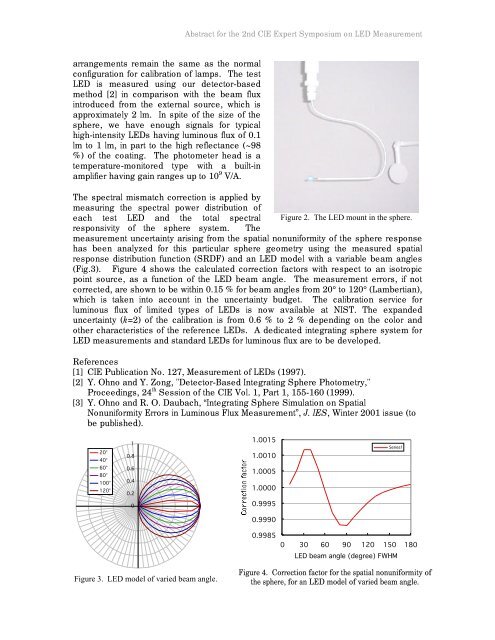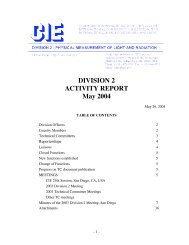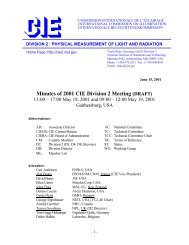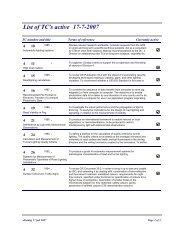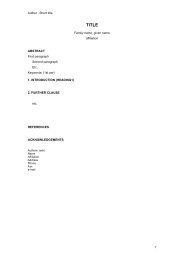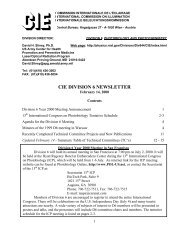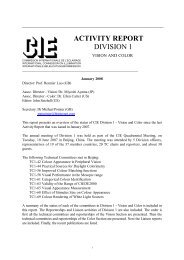Luminous Flux Calibration of LEDs at NIST - cie
Luminous Flux Calibration of LEDs at NIST - cie
Luminous Flux Calibration of LEDs at NIST - cie
Create successful ePaper yourself
Turn your PDF publications into a flip-book with our unique Google optimized e-Paper software.
Abstract for the 2nd CIE Expert Symposium on LED Measurement<br />
arrangements remain the same as the normal<br />
configur<strong>at</strong>ion for calibr<strong>at</strong>ion <strong>of</strong> lamps. The test<br />
LED is measured using our detector-based<br />
method [2] in comparison with the beam flux<br />
introduced from the external source, which is<br />
approxim<strong>at</strong>ely 2 lm. In spite <strong>of</strong> the size <strong>of</strong> the<br />
sphere, we have enough signals for typical<br />
high-intensity <strong>LEDs</strong> having luminous flux <strong>of</strong> 0.1<br />
lm to 1 lm, in part to the high reflectance (~98<br />
%) <strong>of</strong> the co<strong>at</strong>ing. The photometer head is a<br />
temper<strong>at</strong>ure-monitored type with a built-in<br />
amplifier having gain ranges up to 10 9 V/A.<br />
The spectral mism<strong>at</strong>ch correction is applied by<br />
measuring the spectral power distribution <strong>of</strong><br />
each test LED and the total spectral Figure 2. The LED mount in the sphere.<br />
responsivity <strong>of</strong> the sphere system. The<br />
measurement uncertainty arising from the sp<strong>at</strong>ial nonuniformity <strong>of</strong> the sphere response<br />
has been analyzed for this particular sphere geometry using the measured sp<strong>at</strong>ial<br />
response distribution function (SRDF) and an LED model with a variable beam angles<br />
(Fig.3). Figure 4 shows the calcul<strong>at</strong>ed correction factors with respect to an isotropic<br />
point source, as a function <strong>of</strong> the LED beam angle. The measurement errors, if not<br />
corrected, are shown to be within 0.15 % for beam angles from 20° to 120° (Lambertian),<br />
which is taken into account in the uncertainty budget. The calibr<strong>at</strong>ion service for<br />
luminous flux <strong>of</strong> limited types <strong>of</strong> <strong>LEDs</strong> is now available <strong>at</strong> <strong>NIST</strong>. The expanded<br />
uncertainty (k=2) <strong>of</strong> the calibr<strong>at</strong>ion is from 0.6 % to 2 % depending on the color and<br />
other characteristics <strong>of</strong> the reference <strong>LEDs</strong>. A dedic<strong>at</strong>ed integr<strong>at</strong>ing sphere system for<br />
LED measurements and standard <strong>LEDs</strong> for luminous flux are to be developed.<br />
References<br />
[1] CIE Public<strong>at</strong>ion No. 127, Measurement <strong>of</strong> <strong>LEDs</strong> (1997).<br />
[2] Y. Ohno and Y. Zong, "Detector-Based Integr<strong>at</strong>ing Sphere Photometry,"<br />
Proceedings, 24 th Session <strong>of</strong> the CIE Vol. 1, Part 1, 155-160 (1999).<br />
[3] Y. Ohno and R. O. Daubach, “Integr<strong>at</strong>ing Sphere Simul<strong>at</strong>ion on Sp<strong>at</strong>ial<br />
Nonuniformity Errors in <strong>Luminous</strong> <strong>Flux</strong> Measurement”, J. IES, Winter 2001 issue (to<br />
be published).<br />
325 330335340345350355<br />
20°<br />
320<br />
0.8<br />
315 40°<br />
310<br />
305 60° 0.6<br />
300<br />
80°<br />
295<br />
0.4<br />
290 100°<br />
285<br />
280<br />
260<br />
255<br />
250<br />
245<br />
240<br />
235<br />
120°<br />
1<br />
0.2<br />
230<br />
225<br />
220<br />
215<br />
210<br />
205<br />
200<br />
195190185<br />
0<br />
0<br />
180<br />
5 10 15 20 25<br />
3035<br />
40<br />
45<br />
50<br />
130<br />
135<br />
140<br />
145<br />
150<br />
155<br />
160<br />
165<br />
175170<br />
55<br />
60<br />
65<br />
70<br />
75<br />
80<br />
85<br />
90<br />
95<br />
100<br />
105<br />
110<br />
115<br />
120<br />
125<br />
Figure 3. LED model <strong>of</strong> varied beam angle.<br />
Correction factor<br />
1.0015<br />
1.0010<br />
1.0005<br />
1.0000<br />
0.9995<br />
0.9990<br />
0.9985<br />
Series1<br />
0 30 60 90 120 150 180<br />
LED beam angle (degree) FWHM<br />
Figure 4. Correction factor for the sp<strong>at</strong>ial nonuniformity <strong>of</strong><br />
the sphere, for an LED model <strong>of</strong> varied beam angle.


